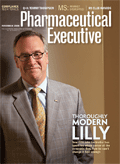Making Sense of Sales
Don't throw out sales force effectiveness with the sales force-some sure-fire strategies
If generics competition, skimpy pipelines, and increased price pressure from managed care haven't done the job, maybe four-dollar-a-gallon gas, the credit crunch, and a sagging global economy will convince you: You need to save money on your sales force.

Kelly Tousi
Face it, the direct sales force is one of the largest costs for most pharma companies, and many companies react to any financial shortfall with a temporary reduction in sales force head count. But in the long run, companies don't need a quick fix. They need to find ways to create built-in efficiencies that will lead to sustainable increases in profitability. To do that, they need to address both sales force size and the underlying benefits and risks of their sales model. And that means they need to challenge the conventional wisdom about pharmaceutical sales, considering alternative selling strategies that align with the needs and preferences of their most important customers.

Angela Bakker Lee
Here are three strategies that deserve consideration.
Put More Products in the Bag
Pharmaceutical companies have long operated under the assumption that pharmaceutical salespeople cannot maintain the high level of expertise required to detail physicians effectively on more than two or three products. But are we selling reps short? Pharma's habit in this area runs counter to sales practices in industries such as high tech, industrial manufacturing, and medical products, where salespeople of similar tenure successfully sell a wide range of specialized products and services to equally demanding customers.
When companies limit the number of products a single salesperson carries, they hinder the rep's ability to adapt to local conditions and offer a product mix that best suits the needs of individual physicians and their patients. It also adds unnecessary costs to the system. Many companies could rationalize sales forces and reduce their costs by as much as 10 to 15 percent—without sacrificing sales force effectiveness—by thoughtfully increasing the number of products that salespeople carry. This sort of change has other benefits as well: It allows greater variability in the product mix from territory to territory and rep to rep, permitting companies to customize sales force resource levels. It also has the potential to reduce demands on physicians' time, easing the irritation of customers who feel they're called on by too many different salespeople from the same company.
Companies with broad product portfolios may need to take an incremental approach to training their salespeople on more products, and making the needed operational changes. For others, it could be a speedy, relatively seamless transition—especially for veteran reps. One salesperson we spoke to has sold almost every product in the portfolio over the last two years as a result of sales force restructuring and alignment changes. If his company were to make this change, salespeople like him would simply have to brush up on a handful of products before they hit the street.
For the sales operations team, adopting this new "highly differentiated" approach to sales force resourcing has many implications for downstream systems and processes that need careful consideration. Some sales operations teams have the tools and resources to take it in stride, but others will need to shore up their capabilities in order to cope with the new demands presented by this model.
In many cases, supporting this kind of change could also require more sophisticated decision-support systems, new business processes, and the development of tailored incentive compensation plans. While management may be concerned that this transformation adds an unnecessary layer of complexity to sales planning and operations, the potential benefits in terms of greater efficiency and cost savings clearly outweigh the risks.
Explore Hybrid Sales Models
Every pharmaceutical company's customer database includes both low-value doctors and "no see" doctors who won't see reps at all. Companies often include these physicians in their direct sales force assignments, planning (and hoping) for a time when the preferences of these customers might change, or when a salesperson might break through and achieve a relationship with them. Yet deploying an expensive door-to-door salesperson to service customers who would either prefer, or do just as well with, a low-cost transactional sales approach is remarkably inefficient.
Many pharmaceutical companies would do well to transition from the idea that "everyone gets a rep" in these situations to a more flexible hybrid sales model that could improve operational efficiency. This approach can often cut costs by 5 to 10 percent.
Other industries have been very successful in using telesales groups to supplement the activities of their field-based sales organizations. Under this hybrid sales model, a field-based salesperson and a telesales rep covering the same geography can coordinate their activities to serve more customers at a lower cost. Someone based in headquarters and working via phone and the Internet, for example, can provide adequate support to meet the needs of a low-value customer or one who is rejecting visits from salespeople, but still welcomes medical information and samples. If a customer's needs or preferences change, and they merit a direct sales call, the field-based representative can easily transition into the lead role.
Though telesales are generally less effective than face-to-face sales visits, it's easy to overestimate the difference between the two approaches. For instance, there have been cases where a telesales team was only 25 percent less effective than their counterparts in direct sales.
A wholesale shift away from direct sales for a majority of customers is unwarranted in the pharmaceutical industry. But companies with an eye toward the future are now making the effort to understand their low-value and "no see" customers, identifying alternative sales models that can potentially serve these groups well, and then carefully testing them to determine the best hybrid approach for their business. To fully implement a hybrid model can be a daunting task. But given the potential boost in profitability it could bring, we believe it is a wise investment for many companies facing substantial pressure from investors to increase profits and earnings.
Expand Account-Based B2B Selling
As more physicians join group practices, sales models in which pharmaceutical salespeople sell principally to individual doctors become less practical. Sales territory design and management projects suggest that a B2B-style sales model that targets decision makers on the account level can maximize sales force effectiveness, and in some cases cut sales-related costs by as much as 20 percent.
Individual physicians are increasingly subject to policies put in place by their employers and the institutions they are affiliated with (such as hospitals and integrated health systems), not to mention the constraints being imposed on them by managed care organizations. Since the majority of reps have little or no access to the decision makers in hospitals or managed care organizations, they spend most of their time with physicians and staff who have limited decision-making power. In these cases, companies would profit by shifting to a B2B sales model that segments customers at the account level, and matches the sales approach to the account's strategic importance and buying preferences.
Expanding the use of this account-based B2B-type sales model often requires changes in sales force structure, wholesale change to the selling process, new training, new tools, and a new support system for salespeople that does not exist today. For salespeople, it requires a significant behavioral shift, a new way of thinking about how and what to sell, new sales performance data and reports to use in the field, and interaction with business stakeholders they may not have had contact with previously. It's not an easy transition, and the learning curve is steep. Yet, our experience suggests that an account-based B2B sales approach will be more effective than the traditional pharma sales model for an increasing number of customers.
Time to Adapt
The world of pharmaceutical sales is in flux. The slowing economy and rising cost of travel are pushing American consumers and companies to reevaluate the way they conduct business—and pharma should be no different. The escalating cost of a direct sales force should act as an impetus for pharmaceutical companies to take a long-term view of their selling practices, address inefficiencies, and add new capabilities. Organizations that equip their sales teams with more products, customize from territory to territory, explore and adopt hybrid sales models, and expand use of account-based selling where appropriate will be better positioned for success and on a path to a brighter—and more profitable—future.
Kelly Tousi is a principal with ZS Associates. She can be reached at kelly.tousi@zsassociates.com
Angela Bakker Lee is a principal with ZS Associates. She can be reached at alee@zsassociates.com
The Misinformation Maze: Navigating Public Health in the Digital Age
March 11th 2025Jennifer Butler, chief commercial officer of Pleio, discusses misinformation's threat to public health, where patients are turning for trustworthy health information, the industry's pivot to peer-to-patient strategies to educate patients, and more.
Navigating Distrust: Pharma in the Age of Social Media
February 18th 2025Ian Baer, Founder and CEO of Sooth, discusses how the growing distrust in social media will impact industry marketing strategies and the relationships between pharmaceutical companies and the patients they aim to serve. He also explains dark social, how to combat misinformation, closing the trust gap, and more.
